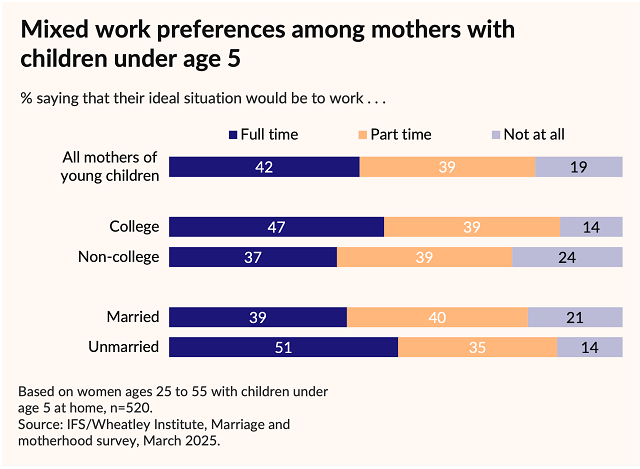Maximize Moms’ Choices: Congress should expand the Child Tax Credit, not publicly-funded daycare
May 12, 2025(CHARLOTTESVILLE, VA)-FOR IMMEDIATE RELEASE
CONTACT: CHRIS BULLIVANT
Fertility has fallen to record lows in the United States, which has fueled interest in family policies to make family life more affordable and attractive. Is devoting more public money to daycare the answer, or is expanding the Child Tax Credit (CTC) a better way?
Expanding the CTC is the better solution, Brad Wilcox, a Senior Fellow at the Institute for Family Studies, told the New York Times in a story on family policy for parents with young children.
“A workist approach to family policy makes it easier to do more work,” Wilcox said, referencing an approach that aims to spend more public money on daycare. “But we are more about policies that make it easier for parents to invest in time with kids, and not privileging a model where both parents are working outside of the home.”
As a proponent of “familist” policies—which make it easier for parents to choose to spend time away from paid work and with their children at home—the Institute for Family Studies (IFS) is in favor of expanding the CTC to $4,500 per child for most families rather than spending more public money on daycare. IFS also favors moving forward with federal legislation for paid parental leave.
This familist approach is more consistent with the pluralistic character of Americans’ family policy ideals, as well as mothers’ contemporary work-family preferences. When it comes to supporting families, a 2021 survey found that many Americans, especially working-class men and women, prefer cash over publicly funded childcare. And a new IFS survey indicates there is no “one size fits all” approach when it comes to mothers’ preferences for paid work and childcare. Specifically, a March 2025 IFS/Wheatley YouGov survey finds that fewer than half of mothers with children ages 0 to 4 (42%) prefer to work full time. A majority (58%) prefer either part-time work or not working for pay at all.

Even among college-educated mothers, a group who are more likely to hold high-paying jobs, only 47% say they prefer full-time work. The share is even lower among non-college- educated moms, with just 37% preferring full-time employment.
Married mothers with young children are much less likely to prefer full-time work than their unmarried peers. Thirty-nine percent of married mothers say they prefer to work full-time, compared with 51% of unmarried mothers. The most popular work option for married mothers is part-time work, with 40% preferring this option.
“The varied family and work preferences of today’s moms suggest that policy efforts to help families with young children should give them choices about how best to raise their children,” said Wendy Wang, Director of Research at IFS.
To make family life more affordable and appealing, the United States should prioritize a policy agenda that allows families to make the choice for themselves about how to care for their children. This is why IFS calls on Congress and the Trump administration to expand the CTC—adopting an approach like the one suggested by IFS Senior Fellow Lyman Stone, who has proposed more than doubling the existing credit to $4,500 per child for most families in a new IFS report.
“Congress and President Trump should work together to deliver a bigger Child Tax Credit for working families,” said Wilcox. “The IFS plan offers a pro-family road map to Congress: it’s more generous to ordinary families than the Ways and Means Committee plan, which would only boost the credit to $2,500, while also honoring work and marriage.”
Wilcox added: “Congress needs to make it easier for working people to raise a family in today’s economy and one of the best ways to do that is to dramatically expand the Child Tax Credit.”














